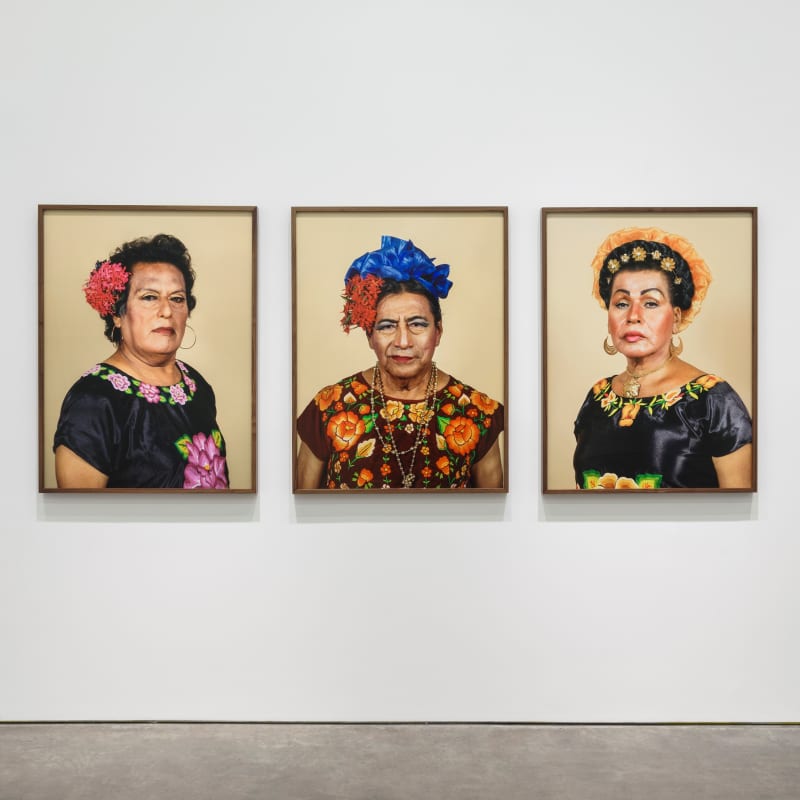A book published by Editorial RM and an exhibition at the Yossi Milo Gallery in New York show Pieter Hugo's seminal encounter with Mexico.
Invited by the curator Francisco Berzunza to do a series of photographs in Mexico on the themes of sexuality and death, Pieter Hugo found his vocabulary. "While I was there, something shifted in my process; the way I make work, the way I look. It got its claws into me and I felt I needed to go back and continue the series," he explained in an interview for Another Man on the occasion of his exhibition in Cologne last November.
While the intensity of his portraits has not changed, his references and the explosion of color and violence set his latest series apart from earlier work. Permeated with the atmosphere of the land-vibrant, full of joy and pain-these photos must be interpreted one by one. Even if Hugo rejects the idea of a global narrative, the work as a whole is grounded in a reaction to a complex sociocultural paradigm.
Escalating over the past fifteen years, and increasingly normalized, violence has fundamentally reshaped Mexican society. There isn't a single person unaffected by the rampant murders; the cartels have made death a part of the daily life and opened the door to other forms of violence, such as organ trafficking and black magic rituals. A few of Pieter Hugo's photos make this violence explicit: corpses set aflame, severed heads, battered bodies, bodies covered in blood or with a shroud. Even a plush toy was disemboweled and pinned to a pole as if it had been the victim of reprisals.
An aesthetics of violence
Revolutionary symbols and references abound, reminding the viewer of the country's history: from Emiliano Zapata, the great revolutionary of 1910, to David Alfaro Siqueiros, the painter and Communist militant whose murals denouncing the dictatorship are reflected in Hugo's compositions. In one photograph, garbage pickers and manual workers are hoisting a dead body they way Siqueiros's revolutionaries once did. They look proud and unyielding, emanating iron will. "It is no accident that it is the cockroach to which Hugo has turned, a creature one loathes as much as one envies, the scavenger and pest that is also the great survivor of any man-made or natural disaster," noted Ashraf Jamal in his introduction. Alluding to a popular Spanish song picked up in Mexico during the Revolution, La Cucaracha, meaning cockroach in Spanish, lends the title to the series.
"A soft answer turns away wrath," says the caption to an image of a naked woman, blood streaming down her face and body. Are these images a form of protest, an expression of admiration for the Mexicans steeling themselves to survive political infighting at the local and international levels, which threatens to engulf them? Beneath the photo of a lifeless man stretched on top of a utility cart and covered with a damp white sheet, we read, as if in confirmation: "Sacrifice to the gods of society." Sacrifice or self-sacrifice? Or yet, acceptance, as the young bride seems to suggest, cradling an iguana in her the immaculate whiteness of her lap? Hugo is aware of the fact that in Mexican culture iguanas represent contentment and the importance of being satisfied with what one has.
Portraying resistance
More radically, says the writer Mario Bellatin, whose text precedes the images in the book: "Pieter Hugo, who in his images seems to have found the key to the appalling desperation of the inhabitants to escape, through the evidence of the liquid quality of their souls, the horror in which their existence is mired."
To complete his aesthetic study of violence and its tangible impact on people and bodies, Hugo adds an innovative touch by foregrounding the nude. Bodies stripped of any artificial attributes seem free to express themselves. They emanate tenderness and joy when they are not opportunities to amass new art and literary references. The latter are present throughout the series: Hugo thus photographed a nude Don Quixote riding his donkey; reproduced a sixteenth-century painting of the Fontainbleau school; and captured modern day odalisques. There is no erotic tension in these images, but rather an expression of complex, disconcerting ambivalence which Hugo is trying to puzzle out. The same ambivalence hovers over the flower which concludes the series: its soft pink petals contrast with the prickly thorns framing the buds.

